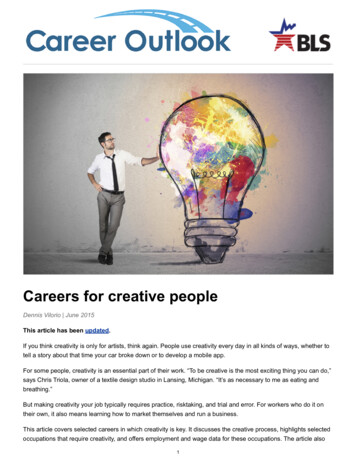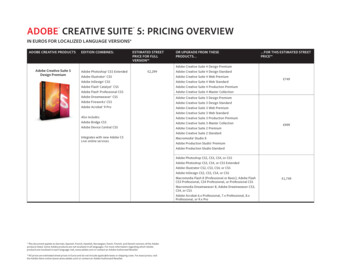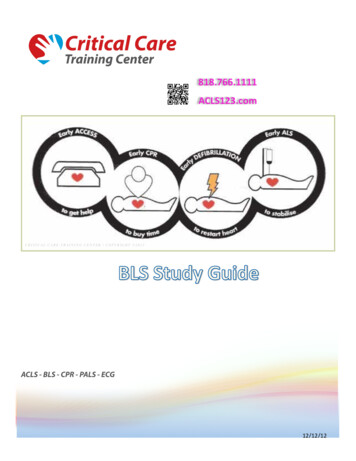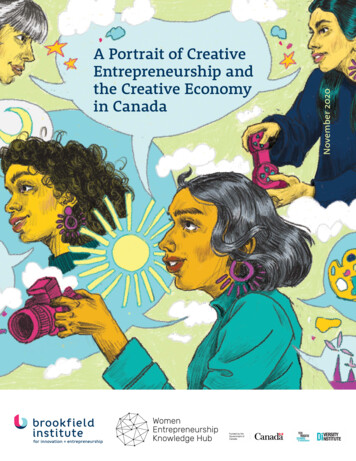
Transcription
Careers for creative peopleDennis Vilorio June 2015This article has been updated.If you think creativity is only for artists, think again. People use creativity every day in all kinds of ways, whether totell a story about that time your car broke down or to develop a mobile app.For some people, creativity is an essential part of their work. “To be creative is the most exciting thing you can do,”says Chris Triola, owner of a textile design studio in Lansing, Michigan. “It’s as necessary to me as eating andbreathing.”But making creativity your job typically requires practice, risktaking, and trial and error. For workers who do it ontheir own, it also means learning how to market themselves and run a business.This article covers selected careers in which creativity is key. It discusses the creative process, highlights selectedoccupations that require creativity, and offers employment and wage data for these occupations. The article also1
U.S. BUREAU OF LABOR STATISTICSCareer Outlookexplains some of the rewards and challenges of creative work, describes how to get started in a creative career,and lists resources for more information.The creative processCreativity can be defined as the ability to produce something of value thatdid not exist before. You could harness creativity to design a product,make a blueprint, or write a script, for example. The outcomes of creativework may be wildly different among individual people or disciplines, butthere are often similarities in the process.The creative process often starts with a spark of inspiration: An idea. Itcan come at any time and from anywhere, such as from nature or people.When thinking of ideas for a fabric pattern, for example, Triola looks inunexpected places, including cracks in ice or the lines on a cabbage leaf.But inspiration alone is not enough for creating. Creativity requires hardwork and patience to turn ideas into viable output. Workers increase theirchances of success through planning, assessing, revising, and reflectingon their work.Planning is important because it helps creative workers find focus anduse their time wisely. By setting aside time for practice and research, forexample, workers can improve their craft and connect ideas.Planning can also make a project seem less daunting. For example, workers may break up a project into severalsmall tasks and schedule time to create every day. Steady effort often leads to noticeable results. “When I lookback, I realize that my art is constantly evolving,” says freelance illustrator Daniel Dufford of Cincinnati, Ohio. “Aslong as you keep working, you’ll keep getting better.”Throughout the creative process, workers should assess and revise their work. For example, a writer proofreadsan article draft to ensure that its message is clear with no gaps in logic. Making a timeline and requesting feedbackfrom clients, collaborators, and others may help workers stay on track.After completing creative tasks, successful workers reflect on what they’ve learned during the process. They mayreview, for example, how often they practiced and what helped them do so more consistently. By applying theselessons to future creative endeavors, workers can improve their efficiency in finishing tasks.Occupations for creative workersMost occupations involve some form of creativity. A retail salesperson, for example, might design a more engagingproduct pitch, and a physicist might devise some new way of understanding nature.2
U.S. BUREAU OF LABOR STATISTICSCareer OutlookIn some occupations, creativity is an integral part of the job. Among these occupations are those for artists andrelated workers, designers, and media and communication workers. (For a list of other occupations that mayinvolve creative skills, including some that you might not expect, see the box.)Artists and related workersArtists and related workers create aesthetic pieces that try to capture certain beliefs, feelings, or ideas. Forexample, a painter may try to express happiness through a watercolor landscape of a summer day. These workerstypically develop a unique style.The occupations described in this category include art directors, craft artists, fine artists, and multimedia artists.Art directors. Art directors design the vision for a product or work of art. They decide which artistic styles andelements to use, and they supervise artists. Art directors work primarily in visual communications media, includingadvertising, publications, video games, theater, and film.Craft artists. These artists create handmade arts and goods using a variety of raw materials, such as wood,metal, and fabric. Craft artists may sell their work at craft fairs, in art studios, or to customers directly oncommission. Examples of these artists are quilters, woodworkers, potters, and jewelers.Fine artists. Fine artists use visual techniques to as a form of creative expression. These artists study traditionalart disciplines, such as painting and sketching. Fine artists showcase and sell their works at galleries and studios,through a broker, or to customers directly. Occupations include illustrators, painters, cartoonists, and sculptors.3
U.S. BUREAU OF LABOR STATISTICSCareer OutlookMultimedia artists. These artists combine visual art with a variety of forms, such as sound, storytelling, oranimation. With the help of film, cameras, computers, and other tools, multimedia artists create video games,commercials, music videos, and more. Examples of occupations are special effects artists, 3D animators, andgame designers.DesignersDesigners make original creations that have practical or aesthetic purpose. Businesses in nearly all industries relyon designers to develop and implement ideas for products or services. Designers may start a project by sketchingideas on paper or creating a computer prototype. Feedback from clients and staff members helps refine the ideasinto a final product.The following design occupations described are commercial and industrial, fashion, floral, graphic, interior, and setand exhibit designers.Commercial and industrial designers. These designers focus on how customers interact with technical productsand services, such as cell phones and online marketplaces. By researching and collecting data on customerbehavior and market needs, these workers improve artistic design and ease of use, and ensure integration withexisting products or services.Commercial and industrial designers usually work on teams with engineers, managers, and other designers.Fashion designers. Fashion designers create clothing, accessories, and footwear. For each product, they choosefabrics, colors, and patterns that are practical and have aesthetic appeal. They may develop original designs oradapt fashion trends. Some products have a recurring theme, such as a similar color palette or style, and aredesigned as part of a collection.Fashion designers may oversee production of the garments, ensuring that workers such as seamstresses followthe designs. Often, they market their products to retailers and customers at fashion and trade shows.4
U.S. BUREAU OF LABOR STATISTICSCareer OutlookFloral designers. These designers create arrangements with live and dried flowers and foliage. For eacharrangement, they must consider the occasion—such as a wedding or birthday—and the customer’s needs,budget, and preferences.Floral designers may order flowers from wholesalers or grow their own. They must learn each flower’s properties,including its season and colors, the sentiment it conveys, and how to care for it.Graphic designers. Graphic designers visually communicate ideas and messages for commercial or promotionalpurposes. Using words, images, and symbols, these designers tweak style elements—such as color andtypography—to create posters, logos, packaging, and other products.Graphic designers usually work for an art director or for a client directly. They also may work closely with people inadvertising, communications, and marketing.Interior designers. These designers plan and furnish the insides of residential, commercial, and industrial spaces.They consider the aesthetics, safety, and function of each space, as well as the client’s needs and budget.Interior designers create a plan to specify design elements, such as lighting fixtures, furniture, and flooring. Theplan also estimates the project’s cost and timeline.Interior designers often work with architects, engineers, and builders. They may specialize in a particular style orfield, such as sustainability, renovation, or kitchen design.5
U.S. BUREAU OF LABOR STATISTICSCareer OutlookSet and exhibit designers. Set and exhibit designers develop and prepare displays and spaces for theater, film,museum, and industry events. They coordinate with clients and consider the design’s budget, timeline, andpurpose.Designers collaborate with workers in charge of lighting, special effects, props, and construction. They also consultwith experts to understand elements from a style or period, and they inspect the finished set or exhibit to ensurethat it matches their design.Media and communication workersMedia and communication workers use words or images to convey information and ideas. Some write fictionalstories, and others capture information or actual events, such as breaking news.Among these creative occupations are editors, photographers, technical writers, and writers and authors.Editors. Editors plan, review, and revise written material for publication. They coordinate with writers to exploreideas, establish a schedule, and maintain style standards. When reviewing and revising drafts, editors try topreserve the author’s voice while verifying facts, correcting grammar, and reorganizing content to improvereadability. Examples include technical and managing editors.Photographers. Photographers use cameras, lenses, computers, and other equipment to produce images. Theyphotograph people, landscapes, architecture, food, merchandise, or other subjects, depending on their specialty orthe type of project for which they are hired.Many photographers are freelancers, but others work for an employer, such as a newspaper or magazine.Photographers are often grouped by the type of images they create. Examples are news, medical, and portraitphotographers.6
U.S. BUREAU OF LABOR STATISTICSCareer OutlookTechnical writers. These writers communicate complex information to a general audience. They write instructionmanuals, supporting documents, and other types of explanatory text. Increasingly, they incorporate graphics and,in electronic resources, sound and video to improve readers’ comprehension.Technical writers often collaborate with other workers, such as product designers, engineers, and customersupport specialists. These other workers help writers understand the product and obtain data for diagrams andcharts; they also offer feedback on drafts and the final product.Writers and authors. Writers and authors compose materials for print and online publications, films and televisionshows, advertisements, and more. They may write fiction or nonfiction pieces, and their work might include scripts,novels, or articles.To get started, writers often research their subject matter. They also brainstorm ideas to create an outline thatgives their draft structure. With the help of editors, writers and authors revise a draft until it is ready to bepublished.Examples of writers and authors are screenwriters, biographers, playwrights, novelists, copy writers, and bloggers.Wages, employment, and outlookWages, employment, and outlook vary among creative occupations. In most of the occupations described in thisarticle, data from the Bureau of Labor Statistics (BLS) show that wage and salary workers earned more than the 35,540 median annual wage for all workers in May 2014.7
U.S. BUREAU OF LABOR STATISTICSCareer OutlookBut those data do not include wages for the many self-employed workers in nearly all of these occupations. And,although employment growth is projected to be slow for most of them, the need to replace workers who leave theoccupations is expected to result in opportunities.WagesAccording to the BLS Occupational Employment Statistics survey, wages were higher than the overall median innearly all of these occupations in May 2014. (See table 1.) However, these estimates do not include wages for selfemployed workers, whose incomes may vary more widely than those of wage and salary workers overall.Table 1. Wages for selected creative occupations, May 2014OccupationMedian annual wage, May 2014Artists and related workersArt directors 85,610Craft artists31,080Fine artists, including painters, sculptors, and illustrators43,890Multimedia artists and animators63,630DesignersCommercial and industrial designers64,620Fashion designers64,030Floral designers24,750Graphic designers45,900Interior designers48,400Set and exhibit designers49,810Media and communication workersEditors54,890Photographers30,490Technical writers69,030Writers and authors58,850All occupations35,540Source: U.S. Bureau of Labor Statistics, Occupational Employment Statistics survey (excludes self-employed).Wages varied by geographic location, with workers in some metropolitan areas typically earning more than thosein other cities. For example, graphic designers in the San Francisco metropolitan area earned a median annualwage of 74,930, compared with the median annual wage of 49,110 earned by graphic designers in the Chicagometropolitan area.Wages also varied by industry. For example, technical writers in the specialized design services industry earned amedian annual wage of 86,990, compared with technical writers in the newspaper publishers industry who earneda median annual wage of 54,600 per year.8
U.S. BUREAU OF LABOR STATISTICSCareer OutlookEmployment and outlookAccording to data from the BLS Employment Projections (EP) program, employment size was relatively small in2012—the base year for the most recent projections data—in many of the creative occupations discussed in thisarticle. Employment projections data include self-employment, which was common in these occupations. Jobopenings are projected to vary between 2012 and 2022. (See table 2.)Table 2. Employment and self-employment, 2012, and job openings, projected 2012-22, for selectedcreative occupations2012OccupationEmploymentProjected 2012-22Percent self-Job openings due to growth andemployedreplacement needsArtists and related workersArt directors74,8005720,000Craft mercial and industrial designers39,2002512,100Fashion designers22,300255,900Floral designers62,4002616,500Graphic designers259,5002486,000Interior designers54,9002521,500Set and exhibit Fine artists, including painters,sculptors, and illustratorsMultimedia artists and animatorsDesignersMedia and communication workersTechnical writersWriters and authorsSource: U.S. Bureau of Labor Statistics, Employment Projections program.In 2012, employment for the occupations in table 2 was almost 1.1 million. Employment by occupation variedacross industries. For example, nearly half of all floral designers were employed by florists. By comparison, editors’employment was less concentrated in a single industry: 18 percent worked for newspaper publishers, 10 percentwere self-employed, and the rest found work in numerous industries, including advertising and TV broadcasting.Most occupations listed in the table had a significantly higher rate of self-employment than the 6.5 percent rate forall occupations. This may be because many creative occupations lend themselves to self-employment, which9
U.S. BUREAU OF LABOR STATISTICSCareer Outlookincludes freelance workers and business owners. For example, writers and authors, photographers, and craftartists—occupations listed in the table with the highest rates of self-employment—may be able to generate enoughincome working for themselves if they can successfully sell their creative product.Employment growth is projected to be slow for most of these occupations over the 2012–22 decade. Reasons forslow growth may vary among occupations but include foreign competition and the decline of related industriessuch as publishing media.Employment for technical writers is expected to be faster than the average for all occupations. But even inoccupations that have limited growth, job openings are projected because of the need to replace workers whoretire or leave for some other reason.Rewards and challenges of creative workAs with any career, working in a creative job has pros and cons. This section outlines some of them.RewardsThere are some rewards that are common to most creative work. These include the outlet for being creative, theflexibility of the work, and the opportunity to collaborate with others.Being creative. Engaging in a creative activity is, for many workers, its own reward. Workers do interesting orunique projects while adding their own style.10
U.S. BUREAU OF LABOR STATISTICSCareer OutlookProducing something that didn’t exist before leads to a sense of accomplishment. “Being creative is really fulfilling,”says wedding photographer Kyle Carnes of Portland, Oregon. “You can express yourself and take pride in whatyou create.” News editor Gerri Berendzen of Columbia, Missouri, agrees, adding that she enjoys the adrenalinerush that comes with trying to break a big story—and getting the facts right.Flexibility. Compared with workers in some other career fields, creative workers may have more flexibility inchoosing tasks or setting schedules—especially if they are self-employed.Often, workers have the creative freedom to explore a project or topic as they like. For example, a cartoonistsketching a new superhero character might decide to combine existing ideas, such as a cape, with his or her ownelements, such as the idea of a child superhero. For many workers, exploring and remixing interesting ideas is partof the fun.Collaboration. Creativity often benefits from collaboration, and many people enjoy working with others toward acommon goal. “I find it really satisfying to help an author’s writing get better,” says Berendzen.Even when working alone, people in creative occupations often learn from others. Freelance illustrator Dufford, forexample, browses online art communities and blogs, taking elements of others’ art ideas and reinterpreting them inunique ways. “If you surround yourself with good art,” he says, “you’ll be inspired to create good artwork.”ChallengesAs with almost any career, creative workers may face challenges in their jobs that they need to overcome. Tosucceed, they must be able to handle stress and frustration, accept criticism and failure, and learn to persevere.11
U.S. BUREAU OF LABOR STATISTICSCareer OutlookStress and frustration. Creative workers may feel pressure to constantly produce new or better ideas, sometimesimmediately. But inspiration doesn’t arrive on demand—and the added stress may inhibit creativity even more.It also may be common to work on tight deadlines for long stretches of time or to work at odd hours. And becausecompetition for these jobs is often intense, workers may have a hard time finding enough creative work to earn anadequate income.In some jobs or on certain projects, artistic freedom may be limited. “You have to remember that you’re creating forother people, not yourself,” says Dufford of working for a client. And restricted autonomy may be even morefrustrating when a client changes project requirements without sufficient notice or compensation.Self-employed workers usually face additional frustrations, including managing staff problems, assessing financialrisks, and balancing work–life demands. Deciphering complex laws related to business ownership is also difficult.“I have to pay business, art, and local taxes on top of commercial photography and business licensing fees,”Carnes says. “It can be hard to figure out what you’re supposed to pay.”Criticism and failure. Creative workers imbue a little of themselves intheir creations. Some workers may have difficulty separating from theirwork, which may make them more sensitive to criticism and prone to selfdoubt.But in many creative careers, criticism is necessary. Feedback fromclients, friends, and peers is often part of the creative process. Amongthat feedback may be negative comments that could lead to a differentapproach.And creativity takes a lot of trying—and failing—before an idea comes tofruition. “You have to risk failure and rejection to find success,” saysTriola.Workers should be prepared to put hours of thought or effort into an idea,only to have nothing come of it. “Out of 10 ideas, only 1 might make it,”says industrial design firm owner Austen Angell. “You can’t get attachedto an idea. Keep an open mind.”Perseverance. Often, the polished end product of creativity belies thestruggle that went into achieving it. Turning an idea into a finished product doesn’t happen overnight: creativitytakes a lot of work and perseverance.By focusing on the end result, workers can learn to push themselves. “Creative people are all about ideas, butthat’s the problem: it can be hard to finish one,” says Carnes. “I really enjoy the feeling of accomplishment I getwhen I complete a project.”12
U.S. BUREAU OF LABOR STATISTICSCareer OutlookGetting startedYou’ll need some combination of skills, education and training, and experience to get started in a creative career.Networking and promoting your work are also important.SkillsCreative workers need technical skill relevant to their occupation, which may involve use of certain equipment. Forexample, a craft artist who specializes in woodworking needs to be able to make bevel and groove cuts with a sawand a chisel, among other tools.Communication skills are also important for creative workers. Having ideas is not enough; workers must be able toshare those ideas through writing or speaking. “The single most important skill in a creative field is to learn how touse words to describe what you’re doing so others can understand your vision,” says Triola.And for many people in creative occupations, business skills are pivotal to success—especially for those who areself-employed. “A lot of artists struggle because they’re more concerned with their art than their accounts,” Carnessays.The Small Business Administration and the nonprofit SCORE offer information for small business owners throughfree or low-cost resources and services, including workshops, networking events, and one-on-one mentorships.Education and trainingAccording to BLS, most creative workers typically need a bachelor’s degree to qualify for entry-level jobs. Andworkers in about half of these occupations receive on-the-job training to help them hone their craft. (See table 3.)Table 3. Education, work experience, and training for selected creative occupationsOccupationEntry-level educationWorkexperienceOn-the-job trainingArtists and related workersArt directorsCraft artistsFine artists, including painters, sculptors,Bachelor's degreeHigh school diploma orequivalentHigh school diploma orand illustratorsMultimedia artists and animatorsequivalent5 years or moreNoneNoneNoneLong-term on-the-jobtrainingLong-term on-the-jobtrainingModerate-term on-the-jobBachelor's degreeNoneCommercial and industrial designersBachelor's degreeNoneNoneFashion designersBachelor's degreeNoneNonetrainingDesignersFloral designersGraphic designersHigh school diploma orequivalentBachelor's degree13NoneNoneModerate-term on-the-jobtrainingNone
U.S. BUREAU OF LABOR STATISTICSCareer OutlookTable 3. Education, work experience, and training for selected creative occupationsOccupationEntry-level educationWorkexperienceOn-the-job trainingInterior designersBachelor's degreeNoneNoneSet and exhibit designersBachelor's degreeNoneNoneMedia and communication workersEditorsPhotographersBachelor's degreeLess than 5High school diploma orBachelor's degreeWriters and authorsLong-term on-the-jobNoneequivalentTechnical writersNoneyearstrainingLess than 5Bachelor's degreeShort-term on-the-jobyearsNonetrainingModerate-term on-the-jobtrainingSource: U.S. Bureau of Labor Statistics, Employment Projections program.Getting an education helps workers build a solid technical and artistic foundation—and may improve employmentprospects, even in occupations that don’t typically require a formal program. “My college education really helpedme,” says Dufford. “It taught me how to have the discipline to sit down and work on something continuously.”The more technical the occupation, the more important a college degree may be. For example, beginning artdirectors, multimedia artists, and industrial designers typically need a bachelor’s degree in a field related to theirspecialty. Additional coursework in math, the sciences, information technology, and other disciplines—such aspsychology and sociology—may help jobseekers stand out from other candidates.Creative occupations that usually require a high school diploma at the entry level, such as craft and fine artists andfloral designers, also typically require on-the-job training. For example, a fine artist might work under thesupervision of a master painter for several years to learn a variety of styles and techniques.Creative workers in a few of these occupations, such as illustrators and photographers, may gain experience bystarting out as assistants or apprentices. “Journeying with different people is really useful because you get to seehow they work,” says Carnes.Still other creative workers learn from library or Internet resources or by studying others’ work.But whatever path creative workers take to their career, a common bond is the need for lifelong learning. As withworkers in many fields, workers in creative jobs need to keep up with changes in technology and styles, such as byacquiring new skills, taking classes, or following blogs. “You have to constantly work on improving your skills,”Dufford says. “Keep learning until the day you die.”14
U.S. BUREAU OF LABOR STATISTICSCareer OutlookExperience and networkingAs table 3 also shows, most creative occupations don’t require work experience in a related occupation to qualifyfor entry-level positions. Among the few who do need experience are editors, who typically gain experience byworking in a related occupation, such as editorial assistant, writer, or reporter.Even if experience is not required, however, creative workers usually benefit from hands-on learning, whether paidor unpaid. For example, some workers start out as hobbyists, then turn their passion into a career after discoveringa market for their work.More importantly, gaining experience helps workers gain professional connections. Creative workers must oftentake the initiative to network with peers and employers. This process is often difficult in the beginning, when theseworkers don’t have a large portfolio or many professional connections. But networking gets easier as they build areputation.And networking should include potential clients as well as employers. “You must constantly market yourself,” saysDufford. “I mail out promotional posters to studios and then try to make appointments to meet people at thosestudios. Ninety-nine percent of the time I won’t hear back, but I live off the work that I get from the 1 percent ofpeople who do respond.”Having an online portfolio and a social media presence may help potential clients find your work. Keep in mind thatdeveloping a solid career might take years, so be proactive—and patient. “Each year builds on the one before,”Triola says. “It doesn’t happen overnight.”15
U.S. BUREAU OF LABOR STATISTICSCareer OutlookFor more informationTo learn more about the creative occupations in this article—and hundreds of others—see the OccupationalOutlook Handbook (OOH). Each OOH profile includes information about job duties, employment, wages, joboutlook, and more.The National Endowment for the Arts promotes and funds creativity andart through grants for people and organizations in artistic fields. Theendowment also offers a variety of resources, including podcasts,webinars, and events.Professional associations offer additional career information andresources, such as job boards and networking events. Some occupationsmay have related associations that cater to a specific industry or group,such as minorities or residents of a particular state. The mainprofessional associations for the occupations discussed in detail in thisarticle are listed below.Artists and related workersFor information about art directors, visit: Art Directors Guild Art Directors ClubFor information about craft artists, visit the American Craft Council.There is no single association that caters to fine artists as a whole.Instead, look for associations that cater to a specific type of artist. For example, illustrators may visit the Society ofIllustrators and sculptors may visit the International Sculpture Center.As with fine artists, no single association represents multimedia artists, but there are associations for specific typesof artists. For example, graphic designers may visit the American Institute of Graphic Arts. And workers ininteractive entertainment, such as computer animators and game designers, may visit the Academy of InteractiveArts and Sciences.DesignersFor information about commercial and industrial designers, visit the Industrial Designers Society of America.For information about floral designers, visit the American Institute of Floral Designers.For information about graphic designers, visit: American Institute of Graphic Arts Graphic Artists GuildFor information about fashion designers, visit the Council of Fashion Designers of America.16
U.S. BUREAU OF LABOR STATISTICSCareer OutlookFor information about interior designers, visit: American Society of Interior Designers
Graphic designers visually communicate ideas and messages for commercial or promotional purposes. Using words, images, and symbols, these designers tweak style elements—such as color and typography—to create posters, logos, packaging, and other products. Graphic designers usually work for an art director or for a client directly.











